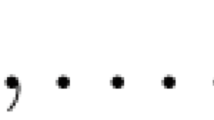Abstract
In this paper, we introduce a new parametric spline curve, named as P-spline curves. Given a control point set associated with a set of knots and parameters, we first define three sets of points using this set of knots and parameters. One set of points lie on a line segment spaced by knots, and two other sets of points lie on two sides of the line segment symmetrically according to the parameters and knots. Then, we compute the mean value coordinates of points on the middle line segment with respect to the two involved quadrilaterals, whose vertices are selected from the three defined point sets. Last, we use these coordinates and blending functions to construct basis functions, which are used to define P-spline curves together with given control point set. There are several desirable features for the P-spline curves. The continuous orders of the resulting curves are determined by the basis functions, and we can adjust the distance between the curves and control points by changing the parameters. Moreover, the construction of P-spline curves is simple, and the relations between the P-spline curves and knots/parameters are intuitive. More importantly, the influences of parameters and control points are local because the four vertices of each quadrilateral only depend on one parameter and three knots. Some numerical examples are used to show that P-spline curves are more local than NURBS (non-uniform rational B-spline) curves, P-curves and P-Bspline curves.











Similar content being viewed by others
References
Farin, G.: Curves and Surfaces for CAGD: A Practical Guide, 5th edn. Morgan Kaufmann Publishers, San Francisco (2001)
Bézier, P.: Numerical Control: Mathematics and Applications. Wiley, New York (1972)
Bézier, P.: The Mathematical Basis of the UNISURF CAD System. Butterworths, England (1986)
Coons, S.A.: Surfaces for Computer Aided Design of Space Figures. MIT Project MAC-TR-255 (1964)
Cox, M.G.: The numerical evaluation of B-splines. J. Inst. Math. Appl. 10(2), 134–149 (1972)
Piegl, L., Tiller, W.: B-spline curves and surfaces. Comput. Aided Geom. Des. 23(91), 95–126 (1974)
Farin, G.: Algorithms for rational Bézier curves. Comput. Aided Des. 15, 73–77 (1983)
Versprille, K.J.: Computer-aided design applications of the rational B-spline approximation form. Syracuse University, PhD dissertation (1975)
Piegl, L.: On NURBS: a survey. IEEE Comput. Graph. 11(1), 55–71 (1991)
Piegl, L., Tiller, W.: The NURBS Book, 2nd edn. Springer, New York (1997)
Loe, K.F.: \(\alpha \)B-spline: a linear singular blending B-spline. Vis. Comput. 12, 18–25 (1996)
Cao, J., Wang, G.Z.: The structure of uniform B-spline curves with parameters. Prog. Nat. Sci-Mater. 18(3), 303–308 (2008)
Cao, J., Wang, G.Z.: Non-uniform B-spline curves with multiple shape parameters. J. Zhejiang U-Sci. C 12(10), 800–808 (2011)
Miura, K.T., Gobithaasan, R.U., Salvi, P., Wang, D., Sekine, T., Usuki, S., Inoguchi, J., Kajiwara, K.: \(\epsilon \kappa \)-Curves: controlled local curvature extrema. Vis. Comput. (2021). https://doi.org/10.1007/s00371-021-02149-8
Kovács, I., Várady, T.: P-curves and surfaces: parametric design with global fullness control. Comput. Aided Des. 90(9), 113–122 (2017)
Floater, M.S.: Mean value coordinates. Comput. Aided. Geom. Des. 20(1), 19–27 (2003)
Kovács, I., Várady, T.: P-Bézier and P-Bspline curves-new representations with proximity control. Comput. Aided Geom. Des. 62(4), 117–132 (2018)
Hormann, K., Floater, M.S.: Mean value coordinates for arbitrary planar polygons. ACM Trans. Graph. 25, 1424–1441 (2006)
Funding
This study was part of the research supported by the National Natural Science Foundation of China (Grant No. 61872121), the Natural Science Foundation of Zhejiang Province (Grant Nos. LY16F020020 and LQ17A010009), Project of the Science and Technology Plan for Zhejiang Province (Grant No. LGF21F020022) and the Natural Science Foundation of Ningbo (Grant Nos. 2019A610033 and 202003N4324).
Author information
Authors and Affiliations
Corresponding author
Ethics declarations
Conflict of interest
The authors declare that they have no conflict of interest.
Additional information
Publisher's Note
Springer Nature remains neutral with regard to jurisdictional claims in published maps and institutional affiliations.
Rights and permissions
Springer Nature or its licensor holds exclusive rights to this article under a publishing agreement with the author(s) or other rightsholder(s); author self-archiving of the accepted manuscript version of this article is solely governed by the terms of such publishing agreement and applicable law.
About this article
Cite this article
Wang, Z., Li, Y., Xu, H. et al. P-spline curves. Vis Comput 39, 4697–4707 (2023). https://doi.org/10.1007/s00371-022-02618-8
Accepted:
Published:
Issue Date:
DOI: https://doi.org/10.1007/s00371-022-02618-8



